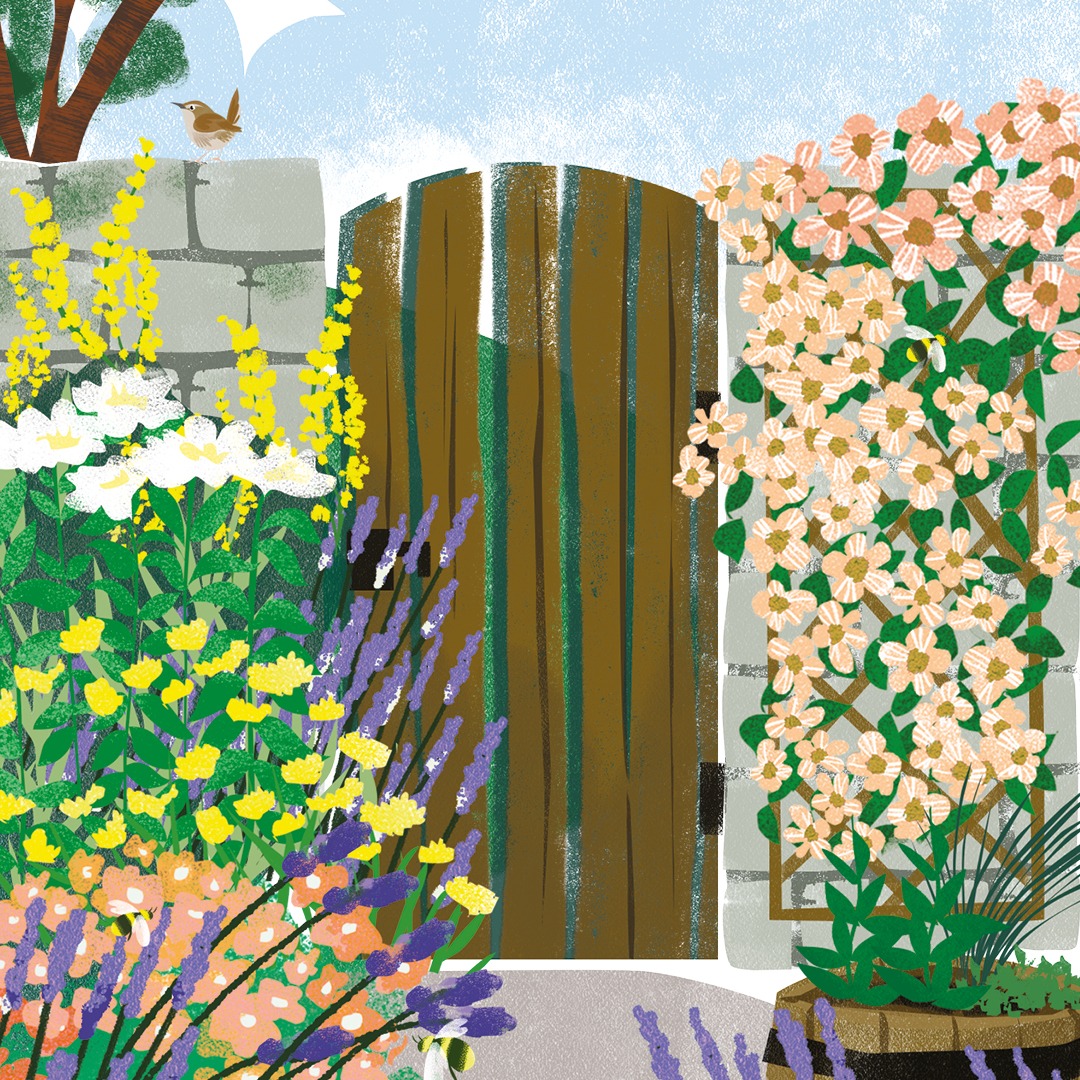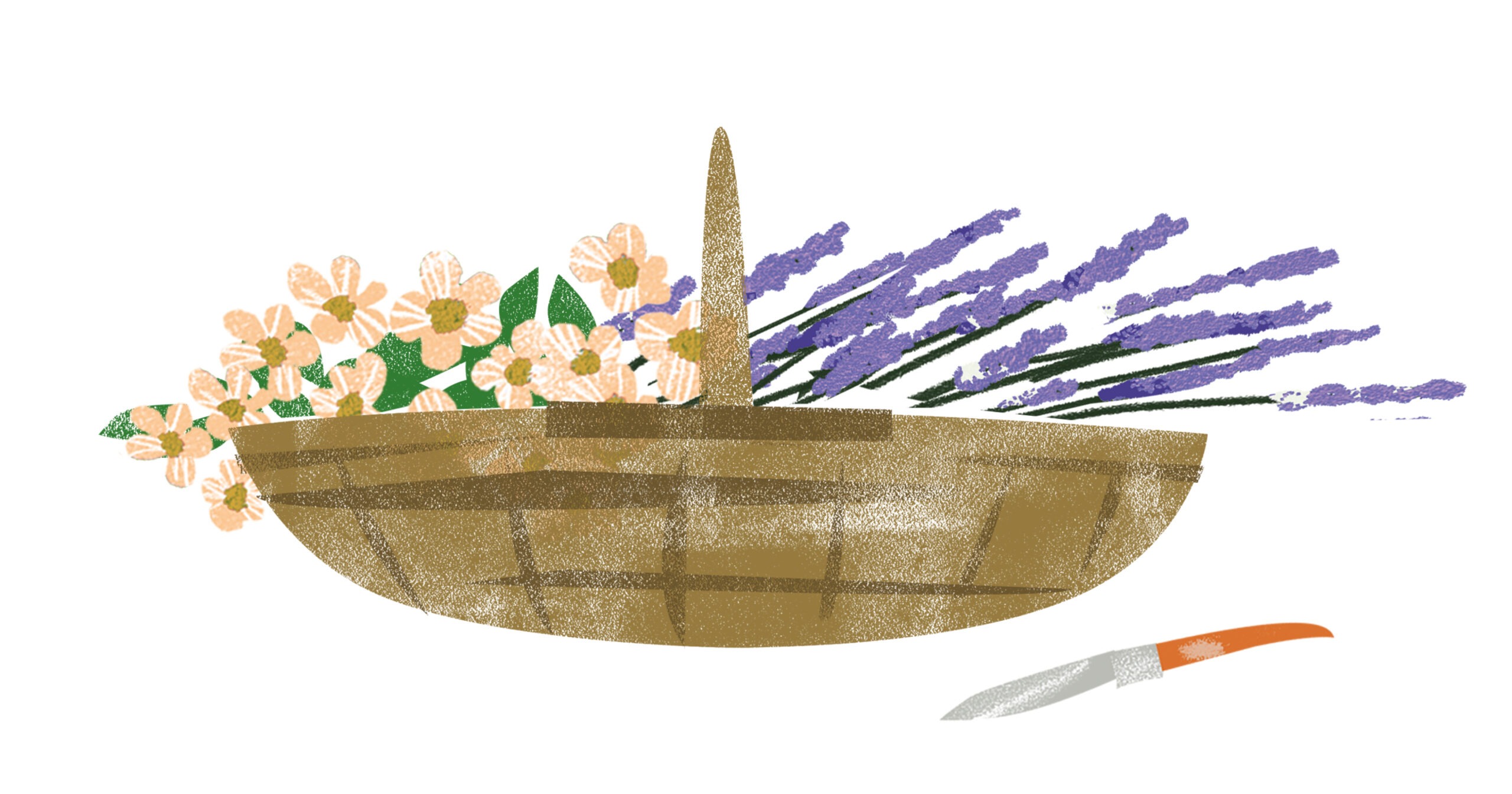As sunshine warms her cheeks, Kirsty listens to the hum of bees pollinating the nearby lavender plants. Her little garden, once unkempt, is now full of flowers, an abundance of roses in soft pinks and vibrant apricots. But the garden isn’t just for show: it’s planted in memory of her grandmother, who passed away a few months ago.
‘It has made me feel much closer to her and brought back lots of memories I’d totally forgotten, which is something I never expected,’ says Kirsty, 29, from Essex in the UK. ‘Every time I’m in the garden, planning or working, I can imagine her talking to me… what she’d say about certain plants, what she’d like, what her advice would be. I know that if she could see it, she’d be very proud, and we’d bond over this hobby together.’
Whether it’s a family member, friend or beloved pet, any loss is painful. But memory gardens – a green space designed to remember someone who you’ve lost – can help the grieving process by pairing the healing power of nature with intention and remembrance.
According to research released in 2024 and commissioned by the Sue Ryder organisation, gardening can play a profound role in helping people to grieve. The charity surveyed more than 1,000 bereaved adults and found that two-fifths said that gardening had ‘saved them from their grief’. More than half said that gardening helped keep their loved one’s memory alive.
You don’t need green fingers or even to have a traditional garden at home: a memory garden can be as simple as a plant pot on a sunny windowsill, a flower trough on a balcony, even an indoor terrarium. Adding other features such as a bird box, wind chimes or a memory plaque is optional, so long as the garden holds meaning to you.
Creating space for grief
Harriet Gross is professor emerita of psychology at Lincoln University and a chartered member of the British Psychological Society. She’s also the author of The Psychology of Gardening. According to Harriet, having a dedicated physical space such as a memory garden to sit and process big emotions can help the grieving process. She explains: ‘It gives people licence to experience those emotions, to feel that they can go somewhere where they feel comfortable or reassured by the surroundings, but also reassured that they can express that emotion by having time to think about the person or situation that they’re in.’
Loss comes in many forms. Often grief comes after a loved one has physically passed away, but in some circumstances it can come beforehand too. For many, it can feel intangible and overwhelming. Taking a few moments to yourself, away from caring duties and clinical settings, in a calming green space, can help clear and steady the mind.
‘When people talk in general terms about the value of gardening… when you go into the garden, you can be taken away. You can be transported from the place you’re in, to a space in your head,’ says Harriet. ‘It’s a mindful experience, where you’re not really thinking, you’re just able to be, and not let things worry you.’
Ritual and routine
Gardens need tending to, whether it’s watering a plant pot or pulling out weeds. When you’re grieving, having this regular routine can provide a sense of purpose and can be a helpful distraction from painful emotions.
‘It’s about being able to go and care for something, and to have a routine where you know that [the garden] won’t answer back; it’s not a person,’ Harriet explains. ‘You can go, you can tend it, but you can interact with it at whatever level you like. That sense of routine and responsibility is a distraction from the negative feelings, but also because it’s a sense of purpose, you feel useful, and your grief is therefore being used to do something else.’
The ritual of physically tending to the garden can also be therapeutic and can engage the senses. Research by Sue Ryder revealed that 91 per cent of people believe that the five senses of touch, taste, sight, sound and smell can trigger emotions and poignant reminders of someone they are grieving.
Katherine Holland is an award-winning garden designer who designed the Sue Ryder Grief Kind Garden at the RHS Chelsea Flower Show 2024. For the garden, Katherine selected plant life that would gently engage the senses year-round. To stimulate smell and touch, she planted fragrant roses and nepetas. For sound, she included grass that would rustle in the wind. Katherine also considered where shadows would fall on the paving throughout the day to add an extra visual element.
‘To me, a grief kind garden creates a safe and sensory sanctuary to sit within the beauty of nature, and either share your own experiences of grief or have a moment of reflection,’ says Katherine.
Planting memories
Remembering the person or animal you have lost can be extremely painful, especially in the early days. But as time goes by, you may decide to seek ways that you can actively evoke happier times spent together. The more recent memories of her grandmother’s decline into dementia were difficult for Kirsty, but filling her garden with her grandmother’s favourite plants – roses and acers – altered the focus.
‘It has helped me immensely,’ says Kirsty. ‘My best, most treasured childhood memories are of spending long summers in the garden, helping her to plant and prune, having tea and cake outside in the sunshine, and her helping me create my own patch in the garden where I grew my first plants – pansies.’
‘It’s a place to remember, but also things in it will prompt those memories, because the plants are meaningful [to you],’ says Harriet. ‘I plant lady’s mantle wherever I go, because it reminds me of my grandfather. Wherever I am, I can hear his voice in my head. Lots of people say that about the importance of being able to create those memories, and particularly, to be able to transfer those memories from place to place, so you’re not leaving them in just one place.’
Planting a shrub, tree or flower in memory of a loved one and watching it grow can also be comforting, a symbol of keeping their memory alive, and a gentle reminder that life goes on, even amid the pain of loss.
Nurturing community
Memory gardens can provide a space to be alongside others who have also experienced loss, whether that’s someone you know or a stranger. Perhaps invite a friend to help you water the garden, or even just to sit and admire it. This may be particularly meaningful on certain dates or anniversaries.
Some local hospices, community centres or charity groups run bereavement gardening groups, if you don’t have a space of your own or would prefer to work communally.
‘All the value of community gardening, or horticultural therapy, is that you have a place to go, somewhere that’s important, whether that’s your own garden or a public space, and you’ve all got a common purpose,’ says Harriet. ‘You’re all there to remember the person and to do the garden, and that gives you a shared history, but also a shared future. You are remembering the past, but you’re also planning for the future by keeping the garden tended as a community.’
Looking to the future of her own memory garden, the space brings Kirsty comfort by making her feel as though her grandmother is still with her, in some form. ‘I think that it’s important [to feel] that the person you grieve and have lost never really leaves you fully,’ she says. ‘Their personality, traits and memories live on in your head and you can imagine what they might say or how they might react or feel. Although it can be painful, it’s also very comforting too.’
Creating a memory garden
Setting intentions
Before you start, Katherine suggests asking yourself a few questions to identify what areas you want to focus on:
- How do you want to feel when you use the space? Calm and reflective? Or energised and happy?
- How would you describe the person you’ve lost in a few words? What is the first thought that comes into your head when you think of them?
- What would you like to remember about them? Did they have a special pastime? Or a favourite fragrance or colour?
Hobbies and pastimes
There are so many ways that someone’s hobby can be woven into a garden,’ says Katherine. ‘If they were a craft beer drinker, you could buy a second-hand cut-down barrel for use as a planter and fill it with herbs that could garnish your own drink to toast them. For birdwatchers, add plants with berries, hips and seeds, such as pyracantha (firethorn), Prunus padus (bird cherry), sunflower and ivy. These plants provide a great food source as well as perches for the birds.
‘You don’t need a massive garden to do this, or an outside space. Houseplants can be used in much the same way, whether the gravel dressing on a pot contains stones from favourite walks, or the pot is painted with a sporting motif or a vintage vehicle.’
Fragrance
‘You could consider what your loved one’s favourite perfume or cologne was and look for plants that form the base notes, whether that’s roses or lavender, or more woody, pine fragrances,’ says Katherine. ‘My mum’s favourite scents were always fresh and citrusy, and while citrus fruits aren’t really practical in a UK garden, I’ve found that mock orange (Philadelphus ‘Belle Etoile’) does a brilliant job in reminding me of her favourite perfumes.’
Simplicity
Your memory garden doesn’t need to be complex or costly. It may be one potted rose on the patio, a tomato plant on the windowsill evoking a homemade pasta sauce or even a simple bird table. It may be something as simple as a framed photo next to pots on an indoor shelf, or a laminated photo propped into an outdoor pot.
Self-compassion
Even with the best care, some gardens will not thrive – and that may feel distressing, or at very least disheartening. Be kind to yourself and remember why you started the garden. ‘The idea of the garden is still the same, which was to remember somebody. Don’t let the failure of the “nature” part say that you’re not remembering that person,’ says Harriet. ‘Just try again. Try a different thing, put it in a different place.’


